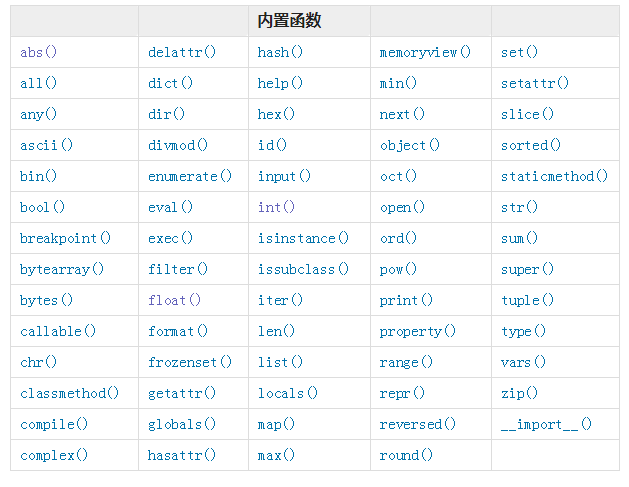python内置函数
pyhton内置函数如下表:

内置函数的详细解读:
1.abs(x):绝对值函数
>>> abs(-1)
1
2.all(iterable):迭代器所有元素为真或空,返回True,否则,返回False
>>> all([1,3,0,3]) False >>> all(()) True
3.any(iterable):迭代器任意元素为真返回True,为空,返回False
>>> any((1,2,3)) True >>> any([]) False
4.ascii(object):返回一个可打印的字符串,如果是非Ascii编码的字符,返回带有\x,\u,\U转义
>>> ascii("张") "'\\u5f20'" >>> ascii("a") "'a'" >>> ascii('a') "'a'" >>> ascii('A') "'A'"
5.bin(x):将一个整数转换为前置为0b的二进制。如果括弧内的不是整数,则需要则需要定义_index_返回一个整数
>>> bin(3) '0b11' >>> bin(-3) '-0b11'
6.bool(x):返回一个boo值,True或者False
>>> bool((1)) True >>> bool(()) False
7.breakpoint(*args,*kws):此函数会在调用sys.breakpoint(),陷入调试器中
8.bytearray([source[, encoding[, errors]]]):返回一个新的bytes数组,是一个可变序列,范围在0<=x<256。
如果 source 为整数,则返回一个长度为 source 的初始化数组;
如果 source 为字符串,则按照指定的 encoding 将字符串转换为字节序列;
如果 source 为可迭代类型,则元素必须为[0 ,255] 中的整数;
如果 source 为与 buffer 接口一致的对象,则此对象也可以被用于初始化 bytearray。
如果没有输入任何参数,默认就是初始化数组为0个元素。
>>>bytearray() bytearray(b'') >>> bytearray([1,2,3]) bytearray(b'\x01\x02\x03') >>> bytearray('runoob', 'utf-8') bytearray(b'runoob')
9.bytes([source[, encoding[, errors]]]):返回一个新的bytes对象,是一个不可变序列,范围在0<=x<256。
如果 source 为整数,则返回一个长度为 source 的初始化数组;
如果 source 为字符串,则按照指定的 encoding 将字符串转换为字节序列;
如果 source 为可迭代类型,则元素必须为[0 ,255] 中的整数;
如果 source 为与 buffer 接口一致的对象,则此对象也可以被用于初始化 bytearray。
如果没有输入任何参数,默认就是初始化数组为0个元素。
>>>a = bytes([1,2,3,4]) >>> a b'\x01\x02\x03\x04' >>> a = bytes('hello','ascii') >>> a b'hello'
10.callable(object):如果实参可调用返回True,否则,返回False。如果实例的类有_call_方法,则可调用
11.chr():用整数做参数(即0~255),返回一个对应的字符
>>> chr(98) 'b'
12.classmethod():将一个方法封装成类
13.compile():将一个字符串编译成字节代码
>>> str = '3*4 + 5' >>> a = compile(str,'','eval') >>> eval(a) 17 >>> str = "for i in range(0,10):print(i)" >>> c = compile(str,'','exec') >>> exec(c) 0 1 2 3 4 5 6 7 8 9
14.complex():用于创建一个值为 real + imag * j 的复数或者转化一个字符串或数为复数。如果第一个参数为字符串,则不需要指定第二个参数
real -- int, long, float或字符串;
imag -- int, long, float
>>>complex(1, 2) (1 + 2j) >>> complex(1) # 数字 (1 + 0j) >>> complex("1") # 当做字符串处理 (1 + 0j) # 注意:这个地方在"+"号两边不能有空格,也就是不能写成"1 + 2j",应该是"1+2j",否则会报错 >>> complex("1+2j") (1 + 2j)
15.delattr():用于删除属性
16.dict():用于创建一个字典
>>> dict() {} >>> dict(a = 'a',b = 'b') {'a': 'a', 'b': 'b'} >>> dict(zip(['one','two','three'],[1,2,3])) {'one': 1, 'two': 2, 'three': 3} >>> dict([('one',1),('two',2)]) {'one': 1, 'two': 2}
17.dir():dir不带参数时返回当前范围内的变量、方法和定义的类型列表,带参数时返回参数的属性、列表方法。如果该参数包含_dir_()则该方法将被调用,如果不包含,则最大限度的收集参数信息。
>>> dir() ['__annotations__', '__builtins__', '__doc__', '__loader__', '__name__', '__package__', '__spec__', 'a', 'c', 'i', 'str'] >>> dir([]) ['__add__', '__class__', '__contains__', '__delattr__', '__delitem__', '__dir__', '__doc__', '__eq__', '__format__', '__ge__', '__getattribute__', '__getitem__', '__gt__', '__hash__', '__iadd__', '__imul__', '__init__', '__init_subclass__', '__iter__', '__le__', '__len__', '__lt__', '__mul__', '__ne__', '__new__', '__reduce__', '__reduce_ex__', '__repr__', '__reversed__', '__rmul__', '__setattr__', '__setitem__', '__sizeof__', '__str__', '__subclasshook__', 'append', 'clear', 'copy', 'count', 'extend', 'index', 'insert', 'pop', 'remove', 'reverse', 'sort']
18.divmod(x,y):把除数和余数结合起来,结果是包含商和余数的元组
>>> divmod(10,3)
(3, 1)
19.emumrate():用于将一个可遍历的对象组合成索引对象
>>> seasons = ['sprong','summer','fall'] >>> list(enumerate(seasons)) [(0, 'sprong'), (1, 'summer'), (2, 'fall')] >>> list(enumerate(seasons,start = 1)) [(1, 'sprong'), (2, 'summer'), (3, 'fall')]
20.eval():用于执行一个字符串表达式,并且返回字符串的值
>>> eval('2*4') 8
21.exec():执行更复杂的python语句
>>>exec 'print "Hello World"' Hello World # 单行语句字符串 >>> exec "print 'runoob.com'" runoob.com
22.filter():用于过滤
23.float():用于将整数和字符串转换成浮点数
24.format():字符串的格式转换
>>>"{} {}".format("hello", "world") # 不设置指定位置,按默认顺序 'hello world' >>> "{0} {1}".format("hello", "world") # 设置指定位置 'hello world' >>> "{1} {0} {1}".format("hello", "world") # 设置指定位置 'world hello world'
25.frozenset():返回一个冻结的集合。冻结后不可删除或添加元素
>>>a = frozenset(range(10)) # 生成一个新的不可变集合 >>> a frozenset([0, 1, 2, 3, 4, 5, 6, 7, 8, 9]) >>> b = frozenset('runoob') >>> b frozenset(['b', 'r', 'u', 'o', 'n']) # 创建不可变集合 >>>
26.getattr():用于返回一个对象属性值
27.globals():以字典类型返回当前位置的全部全局变量
28.hasattr():用于判断对象是否包含对应的属性
29.hash():用于获取一个对象的哈希值
30.hex():用于将十进制转换成十六进制,以字符串的形式表示
31.id():用于获取对象的内存地址
32.input():输入
33.int():用于将字符串或数字转换成整型
34.isinstense():用于判断一个对象是否是已知类型
>>>a = 2 >>> isinstance (a,int) True >>> isinstance (a,str) False >>> isinstance (a,(str,int,list)) # 是元组中的一个返回 True True
35.issubclass(calss,classinfo):用于判断参数 class 是否是类型参数 classinfo 的子类
36.iter():用于生成迭代器
>>> lst = [1,2,3] >>> for i in iter(lst): print(i) 1 2 3
37.len():返回对象长度或对象个数
>>>str = "runoob" >>> len(str) # 字符串长度 6 >>> l = [1,2,3,4,5] >>> len(l) # 列表元素个数 5
38.list():用于将元组转换为列表。
注:元组与列表是非常类似的,区别在于元组的元素值不能修改,元组是放在括号中,列表是放于方括号中。
>>> tuple = (1,2,'hello') >>> List = list(tuple) >>> print(List) [1, 2, 'hello']
39.locals():以字典形式返回当前位置的全部局部变量
40.map():根据函数做相应的映射
>>> map(lambda x: x*2 ,[1,2,3]) <map object at 0x0000000002AD7D30>
41.max():返回给定参数的最大值,参数可以作为序列
42.memoryview ():返回给定参数的内存查看对象
43.min():返回给定参数的最小值,参数可以作为序列
44.next():返回迭代器的下一项,通过调用 iterator 的 __next__()方法获取下一个元素。
# 首先获得Iterator对象: it = iter([1, 2, 3, 4, 5]) # 循环: while True: try: # 获得下一个值: x = next(it) print(x) except StopIteration: # 遇到StopIteration就退出循环 break
45.object():所有类的基类
46.oct():将一个整数转化成八进制字符串
47.open():打开一个文件,创建一个file对象
48.ord():ord() 函数是 chr() 函数(对于8位的ASCII字符串)或 unichr() 函数(对于Unicode对象)的配对函数,它以一个字符(长度为1的字符串)作为参数,返回对应的 ASCII 数值,或者 Unicode 数值,如果所给的 Unicode 字符超出了你的 Python 定义范围,则会引发一个 TypeError 的异常。
49.pow():返回 xy(x的y次方) 的值
>>> pow(2,3)
8
50.print():打印输出
51.property():新式类中返回属性值
52.range():创建一个整数列表,一般和for循环结合使用
>>> for i in range(1,3): print(i) 1 2
53.repr():将对象转化为供解释器读取的形式。
54.reverse():用于反向列表中元素
55.round():返回浮点数x的四舍五入值
>>> print(round(20.33333,3)) 20.333
56.set():创建一个无序不重复元素集,可进行关系测试,删除重复数据,还可以计算交集、差集、并集等。
>>>x = set('runoob') >>> y = set('google') >>> x, y (set(['b', 'r', 'u', 'o', 'n']), set(['e', 'o', 'g', 'l'])) # 重复的被删除 >>> x & y # 交集 set(['o']) >>> x | y # 并集 set(['b', 'e', 'g', 'l', 'o', 'n', 'r', 'u']) >>> x - y # 差集 set(['r', 'b', 'u', 'n']) >>>
57.slice():切片操作
>>>myslice = slice(5) # 设置截取5个元素的切片 >>> myslice slice(None, 5, None) >>> arr = range(10) >>> arr [0, 1, 2, 3, 4, 5, 6, 7, 8, 9] >>> arr[myslice] # 截取 5 个元素 [0, 1, 2, 3, 4] >>>
57.sorted():对所有可迭代对象进行排序操作
>>>a = [5,7,6,3,4,1,2] >>> b = sorted(a) # 保留原列表 >>> a [5, 7, 6, 3, 4, 1, 2] >>> b [1, 2, 3, 4, 5, 6, 7] >>> L=[('b',2),('a',1),('c',3),('d',4)] >>> sorted(L, cmp=lambda x,y:cmp(x[1],y[1])) # 利用cmp函数 [('a', 1), ('b', 2), ('c', 3), ('d', 4)] >>> sorted(L, key=lambda x:x[1]) # 利用key [('a', 1), ('b', 2), ('c', 3), ('d', 4)] >>> students = [('john', 'A', 15), ('jane', 'B', 12), ('dave', 'B', 10)] >>> sorted(students, key=lambda s: s[2]) # 按年龄排序 [('dave', 'B', 10), ('jane', 'B', 12), ('john', 'A', 15)] >>> sorted(students, key=lambda s: s[2], reverse=True) # 按降序 [('john', 'A', 15), ('jane', 'B', 12), ('dave', 'B', 10)] >>>
58.staticmethod ():返回函数的静态方法
59.str():将对象转换成事宜阅读的形式
60.sum():计算总和
61.super():调用父类的方法
class A: def add(self, x): y = x+1 print(y) class B(A): def add(self, x): super().add(x) b = B() b.add(2) # 3
62.type():如果你只有第一个参数则返回对象的类型,三个参数返回新的类型对象
63.vars():返回对象object的属性和属性值的字典对象
64.zip():用于将可迭代的对象作为参数,将对象中对应的元素打包成一个个元组,然后返回由这些元组组成的对象,这样做的好处是节约了不少的内存。我们可以使用 list() 转换来输出列表。如果各个迭代器的元素个数不一致,则返回列表长度与最短的对象相同,利用 * 号操作符,可以将元组解压为列表。
>>>a = [1,2,3] >>> b = [4,5,6] >>> c = [4,5,6,7,8] >>> zipped = zip(a,b) # 返回一个对象 >>> zipped <zip object at 0x103abc288> >>> list(zipped) # list() 转换为列表 [(1, 4), (2, 5), (3, 6)] >>> list(zip(a,c)) # 元素个数与最短的列表一致 [(1, 4), (2, 5), (3, 6)] >>> a1, a2 = zip(*zip(a,b)) # 与 zip 相反,zip(*) 可理解为解压,返回二维矩阵式 >>> list(a1) [1, 2, 3] >>> list(a2) [4, 5, 6] >>>
65._import_:用于动态加载类和函数




 浙公网安备 33010602011771号
浙公网安备 33010602011771号